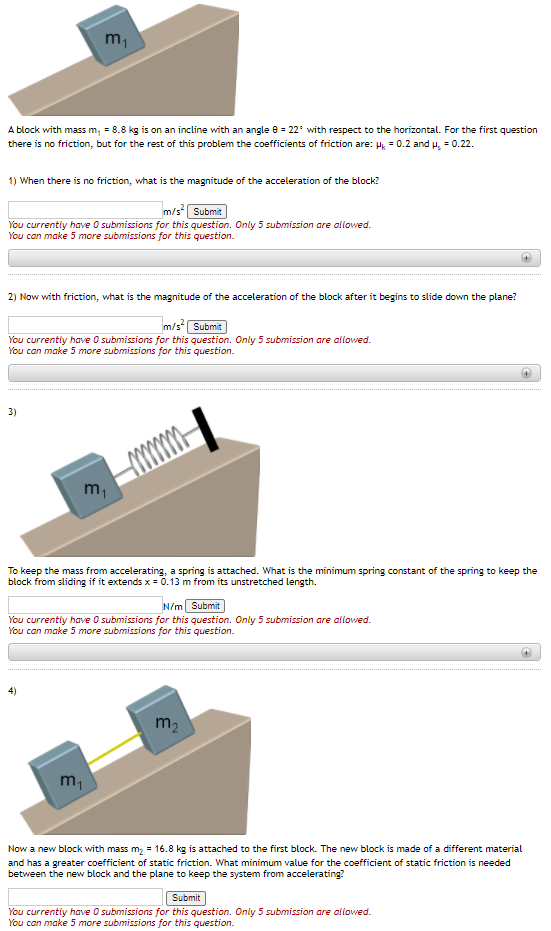there is no friction, but for the rest of this problem the coefficients of friction are: H, = 0.2 and u, = 0.22. 1) When there is no friction, what is the magnitude of the acceleration of the block? m/s Submit You currentiy have O submissions for this question. Only 5 submission are allowed. You can make 5 more submissions for this question. 2) Now with friction, what is the magnitude of the acceleration of the block after it begins to slide down the plane? m/s Submit You currently have O submissions for this question. Only 5 submission are allowed. You can make 5 more submissions for this question. 3) To keep the mass from accelerating, a spring is attached. What is the minimum spring constant of the spring to keep the block from sliding if it extends x = 0.13 m from its unstretched length. N/m Submit You currently have O submissions for this question. Only 5 submission are allowed. You can make 5 more submissions for this question.
there is no friction, but for the rest of this problem the coefficients of friction are: H, = 0.2 and u, = 0.22. 1) When there is no friction, what is the magnitude of the acceleration of the block? m/s Submit You currentiy have O submissions for this question. Only 5 submission are allowed. You can make 5 more submissions for this question. 2) Now with friction, what is the magnitude of the acceleration of the block after it begins to slide down the plane? m/s Submit You currently have O submissions for this question. Only 5 submission are allowed. You can make 5 more submissions for this question. 3) To keep the mass from accelerating, a spring is attached. What is the minimum spring constant of the spring to keep the block from sliding if it extends x = 0.13 m from its unstretched length. N/m Submit You currently have O submissions for this question. Only 5 submission are allowed. You can make 5 more submissions for this question.
Principles of Physics: A Calculus-Based Text
5th Edition
ISBN:9781133104261
Author:Raymond A. Serway, John W. Jewett
Publisher:Raymond A. Serway, John W. Jewett
Chapter5: More Applications Of Newton’s Laws
Section: Chapter Questions
Problem 64P: If a single constant force acts on an object that moves on a straight line, the objects velocity is...
Related questions
Topic Video
Question

Transcribed Image Text:m1
A block with mass m, = 8.8 kg is on an incline with an angle 8 = 22° with respect to the horizontal. For the first question
there is no friction, but for the rest of this problem the coefficients of friction are: H, = 0.2 and u, = 0.22.
1) When there is no friction, what is the magnitude of the acceleration of the block?
m/s Submit
You currentiy have O submissions for this question. Only 5 submission are allowed.
You can make 5 more submissions for this question.
2) Now with friction, what is the magnitude of the acceleration of the block after it begins to slide down the plane?
m/s Submit
You currently have O submissions for this question. Only 5 submission are allowed.
You can make 5 more submissions for this question.
3)
m,
To keep the mass from accelerating, a spring is attached. What is the minimum spring constant of the spring to keep the
block from sliding if it extends x = 0.13 m from its unstretched length.
N/m Submit
You currently have O submissions for this question. Only 5 submission are allowed.
You can make 5 more submissions for this question.
4)
m2
Now a new block with mass m, = 16.8 kg is attached to the first block. The new block is made of a different material
and has a greater coefficient of static friction. What minimum value for the coefficient of static friction is needed
between the new block and the plane to keep the system from accelerating?
Submit
You currently have O submissions for this question. Only 5 submission are allowed.
You can make 5 more submissions for this question.
Expert Solution
This question has been solved!
Explore an expertly crafted, step-by-step solution for a thorough understanding of key concepts.
This is a popular solution!
Trending now
This is a popular solution!
Step by step
Solved in 4 steps

Knowledge Booster
Learn more about
Need a deep-dive on the concept behind this application? Look no further. Learn more about this topic, physics and related others by exploring similar questions and additional content below.Recommended textbooks for you

Principles of Physics: A Calculus-Based Text
Physics
ISBN:
9781133104261
Author:
Raymond A. Serway, John W. Jewett
Publisher:
Cengage Learning

College Physics
Physics
ISBN:
9781305952300
Author:
Raymond A. Serway, Chris Vuille
Publisher:
Cengage Learning

University Physics Volume 1
Physics
ISBN:
9781938168277
Author:
William Moebs, Samuel J. Ling, Jeff Sanny
Publisher:
OpenStax - Rice University

Principles of Physics: A Calculus-Based Text
Physics
ISBN:
9781133104261
Author:
Raymond A. Serway, John W. Jewett
Publisher:
Cengage Learning

College Physics
Physics
ISBN:
9781305952300
Author:
Raymond A. Serway, Chris Vuille
Publisher:
Cengage Learning

University Physics Volume 1
Physics
ISBN:
9781938168277
Author:
William Moebs, Samuel J. Ling, Jeff Sanny
Publisher:
OpenStax - Rice University